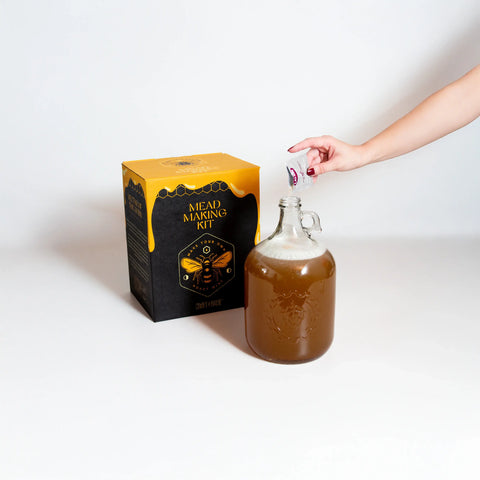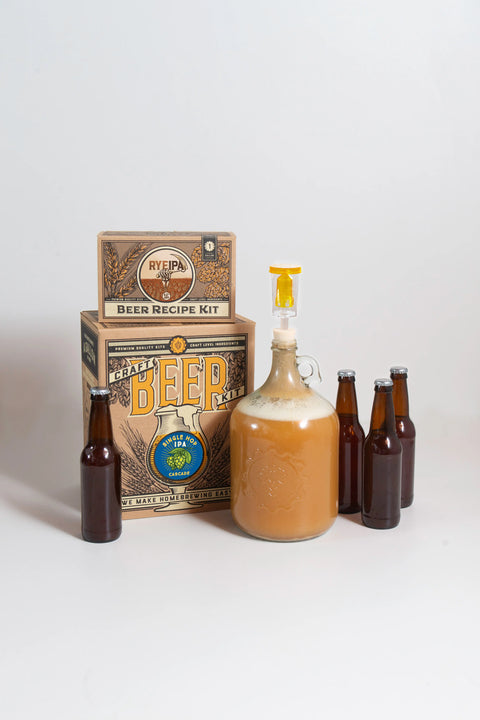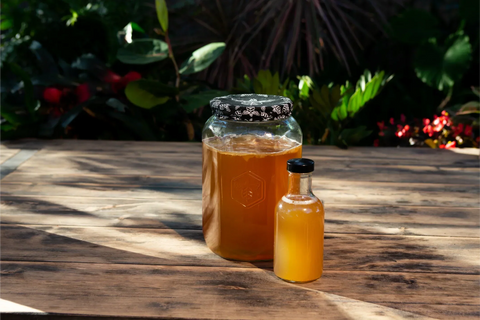TL;DR: The best yeast for mead making depends on your style and goals:
-
Lalvin 71B – ideal for fruit meads (melomels), softens acidity.
-
Lalvin D47 – full-bodied, honey-forward meads with great mouthfeel.
-
EC-1118 Champagne yeast – powerhouse for dry, high-alcohol meads.
-
SafAle US-05 – a neutral ale yeast perfect for low-alcohol meads.
-
Wyeast 4184 – perfect for sweeter or dessert-style meads.
-
Voss Kveik – a fast, flexible farmhouse strain that ferments clean at a wide temperature range. Great for experimental or quick-turnaround batches.
Your choice should match your honey variety, ABV target, and sweetness preference.
Choosing the Right Mead Yeast Strains
Yeast is the engine behind mead fermentation, but it’s also one of the most powerful tools for shaping your final drink. The same clover honey base can taste delicate and floral with one yeast strain or bold and wine-like with another.
When choosing mead yeast strains, consider:
-
Alcohol Tolerance: A session mead (6–8% ABV) calls for a different yeast than a sack mead (15–18% ABV).
-
Flavor Profile: Do you want the yeast to stay neutral and highlight honey, or add fruity or spicy notes?
-
Fermentation Speed: Some strains are slow and steady, others race to the finish line.
-
Sweetness vs. Dryness: Certain yeasts ferment nearly every sugar, while others leave residual sweetness behind.
Top Yeast Picks for Mead Making
You can choose a wine yeast for mead, a champagne yeast for mead, or even a beer yeast for mead! Here are our top mead yeast strains:
1. Lalvin 71B
Best Yeast for Melomel (Fruited Mead)
-
Why: This strain is known for metabolizing malic acid, softening sharp fruit acidity and rounding out the finish. It helps fruit meads feel balanced rather than overly tart.
-
Flavor Profile: Fruity, smooth, approachable.
-
ABV Tolerance: Up to 14%.
-
Perfect For: Berry melomels, tropical fruit meads, or anything with naturally high acidity.
2. Lalvin D47
Best Yeast for Traditional Mead or Spiced Meads (Metheglin)
-
Why: Often compared to a white wine yeast, D47 creates meads with more structure and mouthfeel. It enhances honey character and pairs beautifully with spices in a metheglin.
-
Flavor Profile: Honey-forward, floral, with subtle spice.
-
ABV Tolerance: ~14%.
-
Perfect For: Traditional meads that showcase honey varietals, or spiced holiday-style metheglins.
3. Lalvin EC-1118
Best Yeast for Dry or High-Alcohol Meads (Sack Meads)
-
Why: Known for clean, reliable fermentation, EC-1118 is a champagne yeast for mead, This vigorous strain powers through even tough conditions. It’s highly tolerant of alcohol, making it a go-to for sack meads or sparkling meads.
-
Flavor Profile: Neutral, letting honey and fruit shine without added yeast character.
-
ABV Tolerance: Up to 18%.
-
Perfect For: Traditional dry meads, sparkling meads, and long-aging projects.
4. SafAle US-05
Best Yeast for Session Meads or Low-Alcohhol Meads
-
Why: Though designed as an American ale yeast, US-05 has earned a spot in the world of mead fermentation yeast. Its clean, neutral profile allows honey’s delicate aromatics to take center stage, while its medium attenuation means it won’t always ferment bone-dry. This makes it especially appealing for session-strength meads or brewers who want a smoother, beer-like drinkability.
-
Flavor Profile: Clean, crisp, with minimal ester production. Honey remains the star.
-
ABV Tolerance: ~10–11%.
-
Best For:
-
Session meads (low to mid ABV, ready to drink sooner).
-
Experimental styles like hopped mead or mead-beer hybrids (braggots).
-
Brewers who prefer a neutral yeast that’s easy to manage.
If you’re new to mead making, US-05 is forgiving, widely available, and offers a familiar fermentation profile for those who already brew beer.
5. Wyeast 4184 (Sweet Mead Yeast)
Best Yeast for Sweet or Dessert Meads
-
Why: Leaves more residual sugar behind, making a naturally sweet mead without heavy backsweetening.
-
Flavor Profile: Sweet, rich, and honey-forward.
-
ABV Tolerance: ~11–12%.
6. Lallemand VOSS Kveik 4184
Best Yeast for Fast-Fermenting Modern Meads
-
Why: Originally a traditional Norwegian farmhouse yeast, Voss kveik has found a home in mead making thanks to its speed, flexibility, and flavor. It ferments cleanly at an unusually wide temperature range (68–95°F) and can finish a mead in just a few days compared to weeks or months with traditional strains.
-
Flavor Profile: Clean with subtle citrus-orange esters at warmer temps; neutral when fermented cooler.
-
ABV Tolerance: ~12–13%.
-
Perfect For:
-
Meadmakers who want a quick turnaround batch.
-
Brewers experimenting with fruit-forward melomels (its citrusy edge pairs beautifully with orange blossom honey or tropical fruits).
-
Warmer climates where temperature control is tricky.
Pro Tip: If you want to try something modern and experimental, a Voss kveik mead can be ready to drink weeks earlier than a traditional batch — making it a favorite for impatient meadmakers.
Tips for Working With Mead Yeast
-
Temperature Control: Stay within the yeast’s recommended range for the cleanest results.
-
Nutrients Are Key: Honey lacks natural nutrients. Always use a nutrient and energizer to prevent stuck fermentation.
-
Patience Pays: Even the best yeast strains can benefit from 2–6 months of aging for a smoother character.
-
Experiment: Split a batch and try two different yeasts. It’s the easiest way to understand their impact on flavor.
Final Thoughts: The Best Yeast Depends on Your Mead
There’s no single “best yeast for mead making.” Instead, the right choice depends on your style:
-
71B for fruit-forward melomels.
-
D47 for full-bodied traditional or spiced meads.
-
EC-1118 Champagne yeast for mead when you need power and dryness.
-
US-05 for approachable, smooth, session meads.
-
Wyeast 4184 for naturally sweet dessert-style meads.
-
Voss Kveik for meads that are ready to drink in weeks instead of months.
If you’re just getting started, classic wine yeast for mead like 71B and D47 are reliable, beginner-friendly choices. But as you grow as a meadmaker, experimenting with kveik yeast mead or splitting a batch between strains can unlock new flavors and styles — from crisp and dry to bold, fruity, or sweet.
Ready to try different yeast strains in your next batch? Explore Craft a Brew’s Mead Making Kits and Yeast Selection to find the perfect match for your mead.





